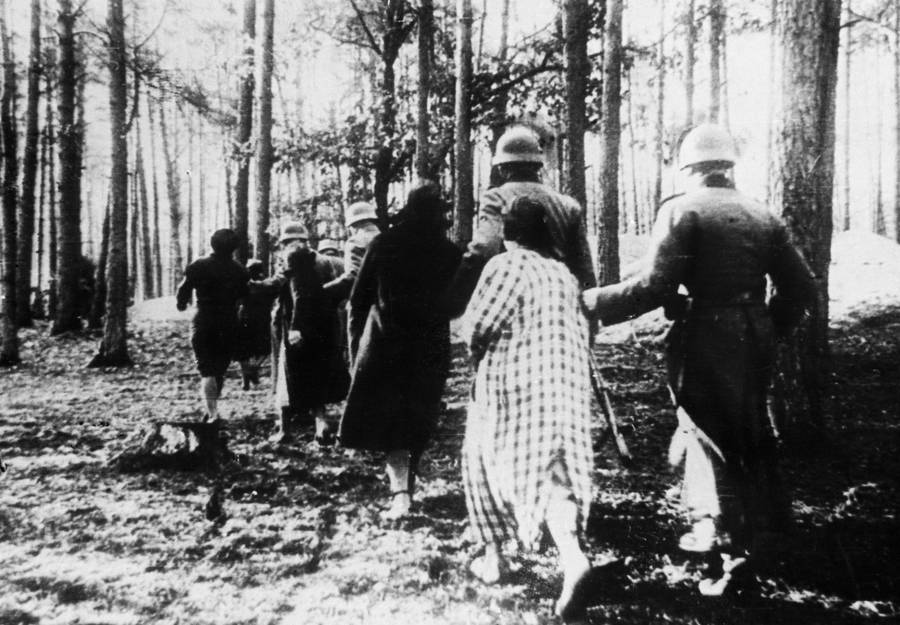SS-Gruppenführer Otto Ohlendorf
(Image - Wikimedia Commons, Bundesarchiv, Bild 183-J08517 / CC-BY-SA 3.0)
Affidavit of Otto Ohlendorf, Head of Einsatsgruppe D
The Einsatzgruppen and Einsatzkommandos were led by personnel from the Gestapo, the SD or the Kriminalpolizei. Additional men were recruited from the Ordnungspolizei and the Waffen-SS. Einsatzgruppe D consisted of some 400 to 500 men and had about 170 vehicles at its disposal. When the German army advanced into Russia I was the commander of Einsatzgruppe D in the southern sector and during the year that it was under my command it liquidated about 90,000 men, women and children. The majority of those liquidated were Jews but there were also Communist officials amongst them.
For the purpose of carrying out this extermination programme the Einsatzgruppen were subdivided into Einsatzkommandos and these Einsatzkommandos subdivided into smaller units: the so-called Sonderkommandos and Teilkommandos. Generally the smaller units were commanded by members of the SD, the Gestapo or the Kriminalpolizei..... In Einsatzgruppe D I never sanctioned shootings by individuals. I always gave orders for several people to shoot simultaneously, in order to avoid any individual having to take direct personal responsibility.
Einsatzgruppen execution in Kovno, Lithuania, 1942
(Image - Wikimedia, public domain)
Statement of Gustave Fix, member of Sonderkommando 6
I would like to mention that as a result of the considerable psychological pressures, there were numerous men who were no longer capable of conducting executions and who thus had to be replaced by other men. On the other hand, there were others who could not get enough of them and often reported to these executions voluntarily.
Statement of teleprinter engineer Kiebach, Einsatzgruppe C
In Rovno I had to participate in the first shooting.....Each member of the firing squad had to shoot one person. We were instructed to aim at the head from a distance of about 10 metres. I can no longer say today who gave the order to fire. At any rate it was a staff officer. There were a number of staff officers present at the shooting. The order to fire was "Ready to shoot, aim, fire!" The people who had been shot then fell into the grave. I myself was detailed to the firing-squad; however, I only managed to shoot about five times. I began to feel unwell, I felt as though I was in a dream. Afterwards I was laughed at because I couldn't shoot any more. A private or lance-corporal from the Wehrmacht, I don't know which unit, took my carbine from me and went and took my place in the firing squad.
I went and stood about 50 metres away from the firing-squad. It was obvious that I was in no state to go on shooting. The nervous strain was too great for me. When I am asked whether I was reprimanded for my refusal, I have to say that this was not the case.
Statement of Viktor Trill, member of Sonderkommando 4a
I still dimly recall our detachment executing fifteen to twenty Jews, including women and four or five children aged between six and 9 months, on the march from Kiev to Poltava...... I can no longer describe the execution area today. I think that I also had to do some of the shooting, but I know for sure that I did not have to shoot any children. I still remember today one of the men saying that the children hung on to life like the adults. He must have shot children.
Members of the Ordnungspolizei shooting naked women and children in the Mizocz ghetto (Image - Wikimedia, public domain)
Statement of Lithuanian Einsatzgruppen member Petras Zelionka
We took them from the ghetto into some forest. In that forest they were shot: men, women, and everyone at the same time. It was our battalion and a German detachment. You could not do it without the Germans. They had machine guns. We had just to shoot, go back to the cars and go away. You just pressed the trigger and shot. And that was it. It was not a big ceremony. Everything short and clear. Without any ceremonies—nothing. We would shoot them, give them up for lost, and that was it. At the edge of the grave, some of them used to say, ‘Long live Stalin!’ The German security forces used to bring us vodka; we could drink as much as we wanted. If they give me, I drink…. Everyone is braver then.
Polish women led to mass execution in a forest near Palmiry village 1940
(Image - Wikipedia, public domain)
(Image - Wikipedia, public domain)
The activity and management reports of the Chief of the Security Police and the SD, No 1, 31 July 1941
All the men coped with the tough physical stress well. No less considerable were the extreme psychological demands made on them by the large number of liquidations The morale and self-possession of the men was kept up by personally reminding them constantly of the political necessity [of what they were doing].
Reference: The Good Old Days: The Holocaust as Seen by Its Perpetrators and Bystanders, published by The Free Press, 21 Oct. 1991







